Maryland: Racing reps tell Senate of progess, urge stability
Racing at Laurel Park. Photo by The Racing Biz.
by Frank Vespe
More racing days. Bowie’s rebirth as a “world-class training facility.” And a Breeders’ Cup at Laurel Park, perhaps in 2022.
Those, the Maryland Senate Budget Committee heard Wednesday during a sunny but superficial hearing, all could be part of the racing future in Maryland.
Left largely unaddressed, however, was what committee vice-chairman Bill Ferguson (D-Baltimore City) called “the elephant in the room”: the future of Pimlico Race Course.
The hourlong session, which included three panels, was designed, Ferguson said, for the Committee “to get a sense of the racing industry overall.” Thorny issues, like what to do about an aging racetrack that hosts one of American racing’s most important races, will be dealt with at a later date.
The third of the three panels was the meatiest, featuring Stronach Group chief operating officer Tim Ritvo, Maryland Thoroughbred Horsemen’s Association (MTHA) president Tim Keefe, and Maryland Horse Breeders Association (MHBA) president Michael Harrison, as well as MHBA executive director Cricket Goodall and lobbyists Joe Bryce and Bob Enten.
All of the panelists praised the partnership among horsemen, breeders, and the racetracks that has helped the industry to grow – and, not coincidentally, to maintain support in Annapolis.
“This industry could not survive without the partnership that has been laid forward,” Ritvo told the Committee.
“The results [of the 10-year deal that the three groups cobbled together several years back] have been remarkable, as we’ve become the talk of the racing industry,” Keefe agreed.
“It is a bit of a family, and there are some differences,” Harrison noted. “But we’re working together because that’s what’s best for the industry.”
Handle, racing days, and breeding statistics all are on the upswing, panelists pointed out to the Committee.
As for the future, Enten, who lobbies for the MTHA, said that more race days was a top priority. “We’d like to see 220 days of live racing,” he said.
Ritvo told the Committee that “Bowie is critical to our future” as a training facility.
And, asked whether the Breeders’ Cup coming to Laurel was a real possibility, he replied, “That’s very real. It’s a real option. We’re looking at hopefully 2022. It’s part of our master plan.”
The day’s first panel, featuring Maryland Racing Commission chairman Michael Algeo and Commission executive director Michael Hopkins, focused on the regulation and condition of the industry.
“I am delighted to report to you that our industry continues to grow, thrive, and prosper as we move into the next decade,” Algeo said in brief prepared remarks, highlighting what he called “the obligation we have as caretakers of this great industry.”
Hopkins agreed.
“One thing that’s indicative [of growth in the industry is that] the live product being marketed throughout the country that emanates from Maryland has more than doubled,” he told the panel. Money wagered on Maryland’s signal has gone from about $240 million in 2010 to about $486 million last year, he said.
The middle panel included representatives from the Maryland Stadium Authority, with Gary McGuigan and Al Tyler walking the panel through the second phase of the Authority’s study on Pimlico.
“We didn’t see any structural factors” that would prevent the rebuilding of Pimlico, McGuigan said.
But of course, the most imposing hurdle of all – where to find $424 million – remains between the present moment and a new Pimlico.
In the meantime, industry participants were focused on delivering a specific message: that the Legislature’s support of racing and breeding, particularly through slots revenue, is helping to fuel a renaissance but that work remains to be done.
“We want to thank you for the support the Legislature has given the industry over the years,” Goodall said, adding that the length of time it takes – from breeding to racing – to produce a racehorse is “why we’re encouraging stability.”
As for Pimlico, Sen. Ferguson said that “there will likely be another day in the near future” to discuss the future of Old Hilltop.
“We will be having many more conversations, I suspect, this session,” he told the panelists at meeting’s end.








